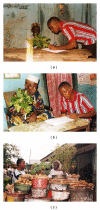Cytotoxic Activity of Crude Extracts as well as of Pure Components from Jatropha Species, Plants Used Extensively in African Traditional Medicine
- PMID: 21754941
- PMCID: PMC3132461
- DOI: 10.1155/2011/134954
Cytotoxic Activity of Crude Extracts as well as of Pure Components from Jatropha Species, Plants Used Extensively in African Traditional Medicine
Abstract
Extracts from Jatropha curcas, a plant used in African traditional medicine for various diseases, were tested for cytotoxic activity. The root extracts strongly reduced cell growth of tumor cells in vitro, a result consistent with the knowledge of the application of these plant extracts in traditional medicine, especially to cure/ameliorate cancer. A selection of pure diterpenoids existing in extracts from Jatropha species and isolated from J. curcas, for example, curcusone C, curcusone D, multidione, 15-epi-4Z-jatrogrossidentadion, 4Z-jatrogrossidentadion, 4E-jatrogrossidentadion, 2-hydroxyisojatrogrossidion, and 2-epi-hydroxyisojatrogrossidion, were likewise tested, and they also showed strong cytotoxic activity. It turned out that these extracts are highly active against L5178y mouse lymphoma cells and HeLa human cervix carcinoma cells, while they cause none or only very low activity against neuronal cell, for example, PC12. These data underscore that extracts from J. curcas or pure secondary metabolites from the plant are promising candidates to be anticancer drug, combined with low neuroactive effects.
Figures





Similar articles
-
New lathyrane diterpenoids with anti-inflammatory activity isolated from the roots of Jatropha curcas L.J Ethnopharmacol. 2021 Mar 25;268:113673. doi: 10.1016/j.jep.2020.113673. Epub 2020 Dec 7. J Ethnopharmacol. 2021. PMID: 33301921
-
Traditional detoxification of Jatropha curcas L. seeds.J Ethnopharmacol. 2019 Sep 15;241:111970. doi: 10.1016/j.jep.2019.111970. Epub 2019 May 22. J Ethnopharmacol. 2019. PMID: 31128150
-
Anti-metastatic effects of curcusone B, a diterpene from Jatropha curcas.In Vivo. 2005 Jan-Feb;19(1):265-8. In Vivo. 2005. PMID: 15796185
-
A review on traditionally used South African medicinal plants, their secondary metabolites and their potential development into anticancer agents.J Ethnopharmacol. 2020 Oct 28;261:113101. doi: 10.1016/j.jep.2020.113101. Epub 2020 Jun 17. J Ethnopharmacol. 2020. PMID: 32562876 Review.
-
Jatropha curcas L., a multipurpose stress resistant plant with a potential for ethnomedicine and renewable energy.Curr Pharm Biotechnol. 2008 Aug;9(4):288-306. doi: 10.2174/138920108785161541. Curr Pharm Biotechnol. 2008. PMID: 18691089 Review.
Cited by
-
Inhibitory effect of isoamericanol A from Jatropha curcas seeds on the growth of MCF-7 human breast cancer cell line by G2/M cell cycle arrest.Heliyon. 2016 Jan 6;2(1):e00055. doi: 10.1016/j.heliyon.2015.e00055. eCollection 2016 Jan. Heliyon. 2016. PMID: 27441238 Free PMC article.
-
Absence of diarrhea in purge nut ingestion: A case series of eight children.J Ayurveda Integr Med. 2013 Jul;4(3):176-80. doi: 10.4103/0975-9476.118710. J Ayurveda Integr Med. 2013. PMID: 24250148 Free PMC article.
-
In vitro activities and mechanisms of action of anti-cancer molecules from African medicinal plants: a systematic review.Am J Cancer Res. 2024 Mar 15;14(3):1376-1401. doi: 10.62347/AUHB5811. eCollection 2024. Am J Cancer Res. 2024. PMID: 38590420 Free PMC article. Review.
-
A review on pharmacological significance of genus Jatropha (Euphorbiaceae).Chin J Integr Med. 2012 Nov;18(11):868-80. doi: 10.1007/s11655-012-1267-8. Epub 2012 Oct 20. Chin J Integr Med. 2012. PMID: 23086490 Review.
-
Plants Producing Ribosome-Inactivating Proteins in Traditional Medicine.Molecules. 2016 Nov 18;21(11):1560. doi: 10.3390/molecules21111560. Molecules. 2016. PMID: 27869738 Free PMC article. Review.
References
-
- Jimu L, Nyakudya IW, Katsvanga CAT. Establishment and early field performance of Jatropha curcas L at Bindura University Farm, Zimbabwe. Journal of Sustainable Development in Africa. 2009;10:445–469.
-
- Hirata Y. Toxic substances of Euphorbiaceae. Pure and Applied Chemistry. 1975;41:175–199.
-
- von Linné C. Species Plantarum. 1st edition. Stockholm, Sweden: Laurenti Salvi; 1753.
-
- von Linné C. Systema naturae, sive regna tria naturæ systematice proposita per classes, ordines, genera, < species. Tomus II; Pars II. Lipsiae, Germany: J. F. Gmelin; 1791.
-
- de Jussieu AL. Genera Plantarum Secundum Ordines Naturales Disposita: juxta methodum in Horto Regio Parisiensi Exaratam. Herissant: Parisiis; 1789.
LinkOut - more resources
Full Text Sources

